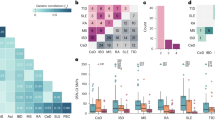Abstract
Clinical exome/genome sequencing is increasingly being utilized by clinicians to diagnose various likely genetic conditions, but many cases remain undiagnosed. In a subset of those undiagnosed cases, a single heterozygous variant in an autosomal recessive (AR) condition with consistent phenotype may be identified, raising the question if a second variant is missing. Here, we report two cases of recessive conditions in which only one heterozygous variant was initially reported by clinical exome sequencing, and on research reanalysis a second heterozygous variant in trans was identified. We performed a review of the existing exome reanalysis literature and found that this aspect is often not emphasized. These findings highlight the importance of data reanalysis in undiagnosed cases where only a single disease-associated variant is identified in an AR condition with a strong link to presenting phenotype.
This is a preview of subscription content, access via your institution
Access options
Subscribe to this journal
Receive 12 print issues and online access
$259.00 per year
only $21.58 per issue
Buy this article
- Purchase on Springer Link
- Instant access to full article PDF
Prices may be subject to local taxes which are calculated during checkout
Similar content being viewed by others
Data availability
The genetic tests analyzed in this paper were ordered as clinical tests and thus the data are not able to be made available for privacy reasons, but these confirmed variants were submitted to ClinVar (#SUB12473625).
References
Lee H, Deignan JL, Dorrani N, Strom SP, Kantarci S, Quintero-Rivera F, et al. Clinical exome sequencing for genetic identification of rare Mendelian disorders. Jama 2014;312:1880–7.
Liu P, Meng L, Normand EA, Xia F, Song X, Ghazi A, et al. Reanalysis of clinical exome sequencing data. N Engl J Med. 2019;380:2478–80.
Schmitz-Abe K, Li Q, Rosen SM, Nori N, Madden JA, Genetti CA, et al. Unique bioinformatic approach and comprehensive reanalysis improve diagnostic yield of clinical exomes. Eur J Hum Genet. 2019;27:1398–405.
Deignan JL, Chung WK, Kearney HM, Monaghan KG, Rehder CW, Chao EC. Points to consider in the reevaluation and reanalysis of genomic test results: a statement of the American College of Medical Genetics and Genomics (ACMG). Genet Med. 2019;21:1267–70.
Wenger AM, Guturu H, Bernstein JA, Bejerano G. Systematic reanalysis of clinical exome data yields additional diagnoses: implications for providers. Genet Med. 2017;19:209–14.
Richards S, Aziz N, Bale S, Bick D, Das S, Gastier-Foster J, et al. Standards and guidelines for the interpretation of sequence variants: a joint consensus recommendation of the American College of Medical Genetics and Genomics and the Association for Molecular Pathology. Genet Med. 2015;17:405–23.
Kim J, Hu C, Moufawad El Achkar C, Black LE, Douville J, Larson A, et al. Patient-customized oligonucleotide therapy for a rare genetic disease. N Engl J Med. 2019;381:1644–52.
MacLennan D, Zorzato F, Fujii J, Otsu K, Phillips M, Lai F, et al. Cloning and localization of the human calcium release channel (ryanodine receptor) gene to the proximal long arm (cen-q13. 2) of human chromosome 19. Am J Hum Genet. 1989;45:A205.
Snoeck M, Van Engelen B, Küsters B, Lammens M, Meijer R, Molenaar J, et al. RYR 1‐related myopathies: a wide spectrum of phenotypes throughout life. Eur J Neurol. 2015;22:1094–112.
Lawal TA, Todd JJ, Meilleur KG. Ryanodine receptor 1-related myopathies: diagnostic and therapeutic approaches. Neurotherapeutics 2018;15:885–99.
Khan S, Muhammad N, Khan M, Kamal A, Rehman Z, Khan S. Genetics of human Bardet–Biedl syndrome, an updates. Clin Genet. 2016;90:3–15.
Nachury MV, Loktev AV, Zhang Q, Westlake CJ, Peränen J, Merdes A, et al. A core complex of BBS proteins cooperates with the GTPase Rab8 to promote ciliary membrane biogenesis. Cell 2007;129:1201–13.
Mykytyn K, Nishimura DY, Searby CC, Shastri M, Yen H-j, Beck JS, et al. Identification of the gene (BBS1) most commonly involved in Bardet-Biedl syndrome, a complex human obesity syndrome. Nat Genet. 2002;31:435–8.
Forsythe E, Beales PL. Bardet–Biedl syndrome. Eur J Hum Genet. 2013;21:8–13.
Fung JL, Yu MH, Huang S, Chung CC, Chan MC, Pajusalu S, et al. A three-year follow-up study evaluating clinical utility of exome sequencing and diagnostic potential of reanalysis. NPJ Genom Med. 2020;5:1–11.
Liu Y, Teng Y, Li Z, Cui J, Liang D, Wu L. Increase in diagnostic yield achieved for 174 whole-exome sequencing cases reanalyzed 1–2 years after initial analysis. Clin Chim Acta. 2021;523:163–8.
Acknowledgements
The authors would like to thank all the subjects’ physicians and caregivers, and especially the patients and families for their participation in this research.
Funding
The Manton Center Gene Discovery Core is supported by a generous gift from The Manton Foundation. This work was also supported by grants NICHD/NHGRI U19HD077671 and by the resources of the IDDRC Molecular Genetics Core funded by U54HD090255 from the NIH.
Author information
Authors and Affiliations
Contributions
QL, RA, KS, CAG, JAM, and PBA drafted the paper. All authors edited the paper and approved the final version.
Corresponding author
Ethics declarations
Competing interests
The authors declare no competing interests.
Ethics approval
The study was conducted in accordance with the ethical standards of the participating Institutional Review Board at Boston Children’s Hospital (IRB number 10-02-0053, approval date 20 May 2021).
Additional information
Publisher’s note Springer Nature remains neutral with regard to jurisdictional claims in published maps and institutional affiliations.
Rights and permissions
Springer Nature or its licensor (e.g. a society or other partner) holds exclusive rights to this article under a publishing agreement with the author(s) or other rightsholder(s); author self-archiving of the accepted manuscript version of this article is solely governed by the terms of such publishing agreement and applicable law.
About this article
Cite this article
Li, Q., Agrawal, R., Schmitz-Abe, K. et al. Reanalysis of clinical exome identifies the second variant in two individuals with recessive disorders. Eur J Hum Genet 31, 712–715 (2023). https://doi.org/10.1038/s41431-023-01291-2
Received:
Revised:
Accepted:
Published:
Issue Date:
DOI: https://doi.org/10.1038/s41431-023-01291-2
This article is cited by
-
2023 in the European Journal of Human Genetics
European Journal of Human Genetics (2024)
-
The complex genomics of single gene disorders
European Journal of Human Genetics (2023)



